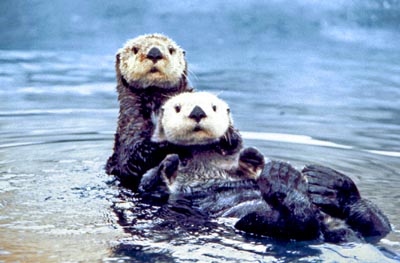Shipwrecked fur traders walked from Oregon Coast to Louisiana
While they were ashore, their sailing ship sank in a storm, leaving four fur traders alone in a vast wilderness with no prospects for rescue. So they set out for Louisiana – and two years later, they arrived.

A pair of sea otters frolicking in the Olympic Coast National Marine
Sanctuary. Hunting pressure from fur traders and trappers eventually
almost eliminated the sea otter population in Oregon, but in 1808 the
little creatures were everywhere. (Photo: Ed Bowlby, U.S. NOAA)
[Larger image: 1200px]
By Finn J.D. John — February 13, 2011
More than two hundred years ago, in late August of 1808, four men stood on the shore of an island near the mouth of the Umpqua River and looked out to sea. An empty ocean stared back at them.
The ship that had carried them all the way from London to Oregon, the 170-ton Sea Otter, was gone — wiped off the face of the sea with every soul aboard by a violent late-summer storm. The four men knew they would be dead, too, if they hadn’t just happened to be on the island instead of aboard ship when the storm blew up. They were a hunting party looking for wild game to feed the Sea Otter’s crew.
And because they were fur traders, no one knew where they were. Secrecy was a big part of the fur trade in 1808. In fact, departing fur traders routinely lied to friends, family members and other mariners about where they were going, just to make sure the competition didn’t find out through some back-channel way.
No — no one would come looking for them. And it would be years before any other ship would come to this remote place on this wild and dangerous coast.
Stranded
So now, just two years after Lewis and Clark’s visit to Oregon, these four men looked out to sea from the edge of the wilderness and knew they were on their own. They had the clothes they were wearing, the rifles they were carrying, a total of six pounds of gunpowder and 20 of lead, and whatever might float ashore from the shipwreck.
These four stranded fur traders were about to embark on possibly the most remarkable overland journey of their century — a century studded with remarkable overland journeys. Over the next two years, they would walk (and, occasionally, float) from the mouth of the Umpqua River, the site of present-day Reedsport, to the mouth of the Mississippi River at New Orleans. And outside of the frontier community in Louisiana, almost no one would ever know about it.
According to the Louisiana Gazette (a newspaper published out of St. Louis), the stranded mariners — Babtiste Lavall, Michael Conner, Jean Lozier and Emmanuel Silver — spent a little time on the island hoping for the best. Most likely they stayed there for the rest of the summer and wintered there by the sea, where they could wait for better traveling weather in the spring and live on fish, saving their precious ammunition.
Then they set out cross-country, heading back toward civilization.
Walking 3,000 miles
These four shipwrecked sailors were setting out to do, with almost nothing, what the Corps of Discovery had done two years earlier with the full resources of the United States government.
A Google map of the possible route taken by Babtiste Lavall and his
fellow castaways as they struck out across the continent from the
Oregon Coast to New Orleans. [View larger map]
There’s really no way of telling precisely what route they choose. Lavalle’s journal, which told the story in some detail, has been lost. We do know they first went east to the Willamette Valley. From there they might have gone south and crossed the Rockies in New Mexico, as travelers following the Interstate highways to Louisiana typically do today; or they might have gone straight across the Oregon high desert and crossed into southern Idaho, where a few years later the Astorian party would get into so much trouble.
Whatever route they chose took them across deserts and swamps and through dense forests. Somehow they got over several rivers. Following Native American trails, they made their way through mountain passes. Lavalle, well schooled in woodcraft from his career as a fur trader, took the lead.
Native Americans: Some friendly, some not so much
The mariners met up with many Native American tribes along the way, many of which were very helpful. Lavalle, like many fur traders and voyageurs of his day, was very careful to be friendly and solicitous of the tribe members (read: “potential customers”) they met, and most of them responded in kind. Others, though, did not — the Gazette article (quoted in Marshall’s book) says at least one tribe tried to hold the men as prisoners. It doesn’t mention how they escaped.
The mariners spent the winter of 1809-1810 somewhere northwest of present-day Amarillo, Texas. Perhaps they stopped to stockpile food and fuel to make it through, or perhaps they found a friendly tribe to take them in for the season; we don’t know.
What we do know is that the summer of 1810 found the four of them floating down the Red River to the Mississippi, and down the Mississippi to New Orleans. They arrived sometime in August, to judge from the date of publication of newspaper reports of their arrival. It had been almost exactly two years since their ship and shipmates had gone down, and they’d covered a good 3,000 miles.
They had made it — all four of them.
Why were they so secretive?
So why did they keep so quiet about an adventure story that rivals, in scale and audacity, the wildest tales of American exploration? The story that got into the Louisiana Gazette was remarkably vague and it’s entirely likely that “Sea Otter” was not the real name of their ship. And so far as I’ve been able to find, no other account of their adventure was published — suggesting that after going home, they kept their mouths shut.
Almost certainly that was to keep other fur traders, especially American ones — remember, these guys were Brits — from finding out where they’d been. As the only four survivors, these mariners were in a great position to return to Oregon and make a killing in otter pelts. Which, one has to assume, they subsequently did — secretly, of course.
We’re fortunate that they weren’t able to keep it completely under their hats, or one of the most amazing and important stories of Oregon history would have gone completely untold.
(Sources: Marshall, Don. Oregon Shipwrecks. Portland: Binford & Mort, 1984; Schoolcraft, Henry R. “Early Adventures in Oregon,” The Literary World, vol. 10, Feb. 19, 1852)
TAGS: #MYSTERIES: #lost #legends #coverUp :: #EVENTS: #shipwrecks :: #PEOPLE: #tough :: # #roadTrip #marine #underdog :: LOC: #douglas :: #113











